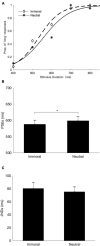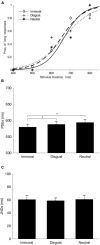Phrase Depicting Immoral Behavior Dilates Its Subjective Time Judgment
- PMID: 35002873
- PMCID: PMC8739786
- DOI: 10.3389/fpsyg.2021.784752
Phrase Depicting Immoral Behavior Dilates Its Subjective Time Judgment
Abstract
Intuitive moral emotions play a major role in forming our opinions and moral decisions. However, it is not yet known how we perceive the subjective time of moral-related information. In this study, we compared subjective durations of phrases depicting immoral, disgust, or neutral behaviors in a duration bisection task and found that phrases depicting immoral behavior were perceived as lasting longer than the neutral and disgusting phrases. By contrast, the subjective duration of the disgusting phrase, unlike the immoral phrase, was comparable to the neutral phrase. Moreover, the lengthening effect of the immoral phrase relative to the neutral phrase was significantly correlated to the anonymously prosocial tendency of the observer. Our findings suggest that immoral phrases induce embodied moral reaction, which alters emotional state and subsequently lengthens subjective time.
Keywords: disgust phrases; embodied timing; emotion; immoral phrases; time perception.
Copyright © 2021 Jia, Shao, Wang and Shi.
Conflict of interest statement
The authors declare that the research was conducted in the absence of any commercial or financial relationships that could be construed as a potential conflict of interest.
Figures




Similar articles
-
People who seem disgusting seem more immoral.Front Psychol. 2024 May 23;15:1395439. doi: 10.3389/fpsyg.2024.1395439. eCollection 2024. Front Psychol. 2024. PMID: 38845773 Free PMC article.
-
"You Should Praise" - "You Should Kill": The Contingent Negative Variation Indicates Moral Goodness and Badness.Front Hum Neurosci. 2019 Dec 17;13:432. doi: 10.3389/fnhum.2019.00432. eCollection 2019. Front Hum Neurosci. 2019. PMID: 31920591 Free PMC article.
-
Harm mediates the disgust-immorality link.Emotion. 2016 Sep;16(6):862-76. doi: 10.1037/emo0000167. Epub 2016 Apr 21. Emotion. 2016. PMID: 27100369
-
[Insula and disgust].Rinsho Shinkeigaku. 2010 Nov;50(11):1000-2. doi: 10.5692/clinicalneurol.50.1000. Rinsho Shinkeigaku. 2010. PMID: 21921543 Review. Japanese.
-
Things rank and gross in nature: a review and synthesis of moral disgust.Psychol Bull. 2013 Mar;139(2):300-27. doi: 10.1037/a0030964. Psychol Bull. 2013. PMID: 23458435 Review.
Cited by
-
Impact of babyface schema on time perception: Insights from neutral and crying facial expressions.Psych J. 2024 Jun;13(3):398-406. doi: 10.1002/pchj.766. Epub 2024 Jun 3. Psych J. 2024. PMID: 38830603 Free PMC article.
References
-
- Angrilli A., Cherubini P., Pavese A., Manfredini S. (1997). The influence of affective factors on time perception. Percept. Psychophys. 59 972–982. - PubMed
-
- Carlo G., Randall B. A. (2002). The development of a measure of prosocial behaviors for late adolescents. J. Youth Adolesc. 31 31–44. 10.1023/A:1014033032440 - DOI
LinkOut - more resources
Full Text Sources

